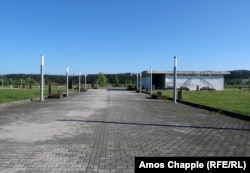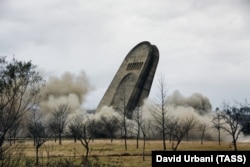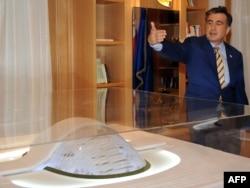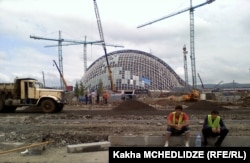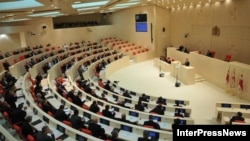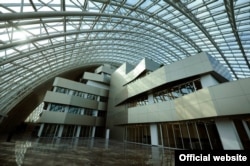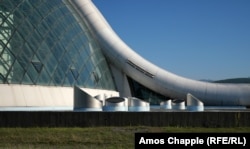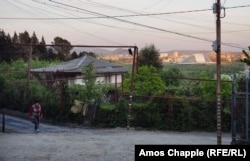The clear shell of the new Georgian parliament building in the city of Kutaisi was supposed to represent the transparency of democracy. But a decade after breaking ground on the ultramodern structure, its glass panels are opaque with dust and its grounds becoming a wasteland after parliament packed up and left in late 2018.
The dome was one of several hypermodern structures unveiled across Georgia during the rule of Mikheil Saakashvili (2004-07, 2008-13). The former president told RFE/RL on May 6 that the current state of the building is “miserable, it’s really sad.”
Saakashvili says he spearheaded the project primarily for military-strategic reasons: “Especially after the [2008 war with Russia]," he says, "the decision to move parliament to Kutaisi was in case Tbilisi comes under attack, we needed a place for the Georgian government to be and for Georgian power to be.
"So we basically made a reserve place for us in case of partial occupation of the country -- and this threat is still there,” he said.
The project got off to a deeply inauspicious start when a towering Soviet-era war memorial behind a sword-wielding horseman was destroyed with explosives to make room for the parliament building.
Flying chunks of concrete from the blast killed a local woman and her 8-year-old daughter.
The building was designed by a Spanish architectural firm and signed off by Saakashvili at a reported cost of $100 million.
When asked about the design, which reportedly suffered from overheating each summer due to its greenhouse-like composition, Saakashvili told RFE/RL: “Look, I believe in glass buildings. I believe in transparency. I believe in public control.”
Saakashvili says another reason Kutaisi was chosen for the parliament building was because “the public should have easy access to [parliament]. And geographically [Kutaisi] is the center of Georgia, so if you just put it in Tbilisi, that’s just one part of Georgia, and a big part of Georgia feels kind of sidelined.”
Shortly after the glassy dome was opened for official duties in 2012, Saakashvili’s party lost parliamentary elections to Georgian Dream, a political coalition founded by Bidzina Ivanishvili, the country’s wealthiest man. The new ruling party then began returning the work of parliament to the capital, Tbilisi.
Members of the ruling Georgian Dream coalition cited the impracticality and cost of splitting the work of government between Tbilisi -- where other branches of government operate -- and Kutaisi. The cities are separated by a 230-kilometer drive that includes a winding and dangerous mountain road.
Saakashvili argues that returning parliament to Tbilisi will, in the long-term, have "very negative repercussions" for Georgia. Locals say the economic buzz of having parliamentarians and their staffers in Kutaisi would have continued in the revitalization of the city, which has struggled to find relevance in Georgia’s modern economy.
“The entire world developed towards the sea,” Saakashvili says, “and Georgia is one of the very few countries in the world where the seaside is strongly underdeveloped. Kutaisi is closer to the sea, so we wanted to tie it to the development of the entire seaside region, including [the breakaway Georgian region of] Abkhazia.”
All parliamentary work ceased in Kutaisi in late 2018 and the building was later put up for sale, though it failed to find a buyer. As of May 2021, the structure was under the control of the Economy Ministry and no longer for sale. A communications officer for the ministry acknowledged but did not respond to questions about the current status of the building.
When RFE/RL visited the site in May, there were six cars in the parking lot and a policeman stationed at the entrance who did not allow entry to the building.
Saakashvili, who now lives in Ukraine, says he believes the work of Georgia's parliament "will be returned" to Kutaisi's fading glass dome.
While there is no indication that will happen anytime soon, one figure that has made a return is the sword-wielding horseman that was the lead figure of the Soviet-era monument demolished in 2009. After spending 12 years in storage, the horseman has been placed on a newly built plinth facing the unused parliament building. The monument was unveiled on May 9.


